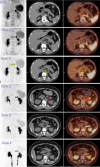68Ga-Pentixafor PET/CT for the assessment of therapeutic outcomes following superselective adrenal arterial embolization in patients with primary aldosteronism
- PMID: 39821475
- PMCID: PMC11739438
- DOI: 10.1186/s13550-024-01194-3
68Ga-Pentixafor PET/CT for the assessment of therapeutic outcomes following superselective adrenal arterial embolization in patients with primary aldosteronism
Abstract
Background: Superselective adrenal artery embolization (SAAE) represents a novel therapeutic strategy for managing primary aldosteronism (PA). Currently, the evaluation of its efficacy is primarily restricted to clinical indicators, with a notable deficiency in imaging evaluation methodologies. In recent years, several studies have investigated the application of 68Ga-Pentixafor PET/CT for the classification of PA. However, there is a scarcity of specific research investigating the role of PET/CT in the evaluation of efficacy of this condition. Consequently, this study aims to evaluate the therapeutic efficacy of SAAE in patients with PA using 68Ga-Pentixafor PET/CT, with the objective of establishing imaging evaluation methodologies for assessing PA patients post-SAAE treatment.
Results: Of the 27 patients, 2 achieved complete clinical remission, while 25 experienced partial remission. Biochemically, 13 patients attained complete remission, 13 had partial remission, and 1 did not. For patients with aldosterone-producing adenoma, both visual and semi-quantitative analyses of PET/CT effectively assessed changes in radioactive uptake of the lesion. For idiopathic hyperaldosteronism patients, PET/CT parameters were more effective than visual analysis in evaluating SAAE efficacy. A significant difference in the ΔTLR-40 min parameter was observed across biochemical outcomes (P = 0.041), with patients having ΔTLR-40 min ≥ 0.07 showing better outcomes (AUC = 0.789, P = 0.041).
Conclusions: 68Ga-Pentixafor PET/CT enables timely assessment of therapeutic outcomes in patients with PA following SAAE, thereby improving clinical decision-making and patient management.
Keywords: 68Ga-Pentixafor; PET/CT; Primary aldosteronism; Superselective adrenal arterial embolization.
© 2025. The Author(s).
Conflict of interest statement
Declarations. Ethics approval and consent to participate: The study was conducted in strict accordance with the ethical principles of the Declaration of Helsinki and received formal approval from the Ethics Review Committee of the First Affiliated Hospital of Chongqing Medical University (Approval Number: 2024-135-01). Consent for publication: Written informed consent was obtained from the patient for publication of this study and accompanying images. Competing interests: The authors have no potential conflicts of interest to disclose.
Figures




Similar articles
-
The utility of 68Ga-pentixafor PET/CT in superselective adrenal artery embolization(SAAE) for treating aldosterone adenomas.Eur J Nucl Med Mol Imaging. 2025 Aug 15. doi: 10.1007/s00259-025-07465-y. Online ahead of print. Eur J Nucl Med Mol Imaging. 2025. PMID: 40815389
-
Typing diagnostic value of 68Ga-pentixafor PET/CT for patients with primary aldosteronism and unilateral nodules.Endocrine. 2025 Jan;87(1):314-324. doi: 10.1007/s12020-024-04024-7. Epub 2024 Sep 9. Endocrine. 2025. PMID: 39251468
-
Clinical Utility of Dual-Time 68Ga-Pentixafor PET/CT in Diagnosing and Subtyping Primary Aldosteronism.Clin Endocrinol (Oxf). 2025 May;102(5):499-509. doi: 10.1111/cen.15204. Epub 2025 Jan 26. Clin Endocrinol (Oxf). 2025. PMID: 39865783
-
The Role of [68Ga]Ga-Pentixafor PET/CT or PET/MRI in Lymphoma: A Systematic Review.Cancers (Basel). 2022 Aug 5;14(15):3814. doi: 10.3390/cancers14153814. Cancers (Basel). 2022. PMID: 35954476 Free PMC article. Review.
-
Imaging findings and clinical relevance of 68Ga-Pentixafor PET in atherosclerosis: a systematic review.BMC Med Imaging. 2023 Oct 26;23(1):166. doi: 10.1186/s12880-023-01134-y. BMC Med Imaging. 2023. PMID: 37884885 Free PMC article.
Cited by
-
Advances in Endocrine Tumor PET Imaging Targeting CXCR4 and GLP-1.Semin Nucl Med. 2025 Sep;55(5):766-775. doi: 10.1053/j.semnuclmed.2025.05.001. Epub 2025 May 29. Semin Nucl Med. 2025. PMID: 40447542 Review.
References
-
- Monticone S, D’Ascenzo F, Moretti C, Williams TA, Veglio F, Gaita F, et al. Cardiovascular events and target organ damage in primary aldosteronism compared with essential hypertension: a systematic review and meta-analysis. LANCET DIABETES ENDO. 2018;6:41–50. 10.1016/S2213-8587(17)30319-4. - PubMed
-
- Funder J. Primary aldosteronism: treatment of the disease, and new therapeutic approaches. BEST PRACT RES CL EN. 2020;34:101368. 10.1016/j.beem.2019.101368. - PubMed
-
- Young WJ. Diagnosis and treatment of primary aldosteronism: practical clinical perspectives. J INTERN MED. 2019;285:126–48. 10.1111/joim.12831. - PubMed
-
- Lim PO, Young WF, MacDonald TM. A review of the medical treatment of primary aldosteronism. J HYPERTENS. 2001;19:353–61. 10.1097/00004872-200103000-00001. - PubMed
-
- Umemura S, Arima H, Arima S, Asayama K, Dohi Y, Hirooka Y, et al. The Japanese society of hypertension guidelines for the management of hypertension (jsh 2019). HYPERTENS RES. 2019;42:1235–481. 10.1038/s41440-019-0284-9. - PubMed
Grants and funding
LinkOut - more resources
Full Text Sources

